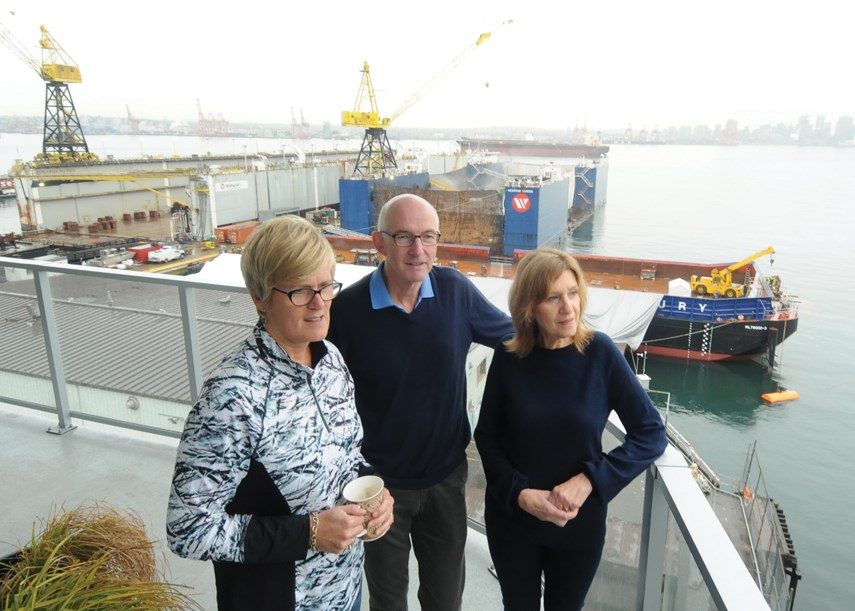Seaspan is seeking Metro Vancouver’s approval to discharge air contaminants from its Vancouver Dry Dock. But the company says it is simply complying with a request from the regional authority and that it has no plans to change what it’s been doing on the waterfront for years.
Specifically, the application seeks a permit to discharge 77.6 tonnes of volatile organic compounds, 22.6 tonnes of particulate matter and 3.12 tonnes of trace metals per year from the dry dock.
“We’re not changing the way we’re behaving. We’ve long operated under environmental and safety guidelines at the Vancouver Dry Dock,” said Tim Page, Seaspan’s vice-president of government relations. “We’re good corporate citizens here on the North Shore of Vancouver, probably the largest commercial employer on the North Shore. We’ll follow the process that Metro Vancouver has laid out.”
The dry docks have been used for repairs and painting vessels since 1992, but only now has the company sought an air quality permit.
“They are on federal land and there has been a view by some people – not me – that because they’re on federal land, they don’t need a permit from Metro Vancouver,” said Ray Robb, Metro’s environmental regulation and enforcement division manager. “We, I guess, convinced them it would be in their best interest to get that permit. … We believe our law applies and we believe it’s in the best interest to pursue that. We will consider all legal avenues available to us to enforce our law.”
The application has raised the concern of residents, particularly those who breathe in what wafts off North Vancouver’s industrial waterfront.
“We’re concerned they’re not taking enough steps to contain the stuff that they’re putting out,” said Gordon Doyle, a resident of one of the condo buildings overlooking the dry dock.
Doyle, a medical doctor, said the company needs to be clearer about what their intentions are for emitting pollution, particularly about which “volatile organic compounds” will be coming from the site.
“That’s a grab-bag of potentially almost anything from things that are probably innocuous to things that are potentially carcinogenic. So it would be nice to know what is actually being put out,” Doyle said.
Under the process now underway, Metro Vancouver collects comments from residents, public health agencies, municipalities and businesses for consideration, which Seaspan will have an opportunity to respond to.
Metro then does an analysis of the potential health and environmental impacts, using dispersion modelling. If and when Metro issues a permit, it typically comes with requirements to mitigate those impacts.
“Even if in our assessment the expected levels are below the levels that we say are OK, we will ensure they employ best available control technology,” Robb said. “We know harm happens below the objectives.”
The process is expected to take about six months. Doyle said he hopes for answers before then.
“The devil is in the details and what is that going to be? And what are the time lines? And how are they going to put in abatement systems and things like that?” Doyle said.
Doyle said the City of North Vancouver should be taking an active role in the matter as they rezoned the land from industrial to residential.
“They have an obligation – a duty – to ensure that it’s compatible with other areas in the city. They should be, if there are emissions, helping us dealing with these,” he said.
Tony Valente, a Lower Lonsdale condo resident and former chairman of the city’s defunct Low Level Road and port area community liaison committee said he was glad to see Metro and Seaspan going through the process.
But, he added, far better would be a cumulative health impact study taking into account all of the industrial operations along the port’s waterfront property. During his time on the committee, Valente lobbied heavily for such a study, but the Vancouver Fraser Port Authority declined. Valente also said the city should take an active role.
“We pushed this densification but we’re right beside industrial lands so how do we manage that? It means everybody has to come together to find a better solution. They’ve got to step up with mitigation and we’ve got to accept the fact that we live where we live,” he said.
The city is expected to vote Monday to hold a public meeting inviting Seaspan, Metro and Vancouver Coastal Health to “present facts” related to the application.
Comments on the application can be emailed to [email protected].



